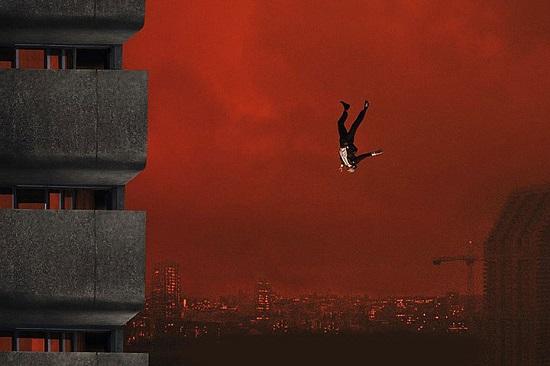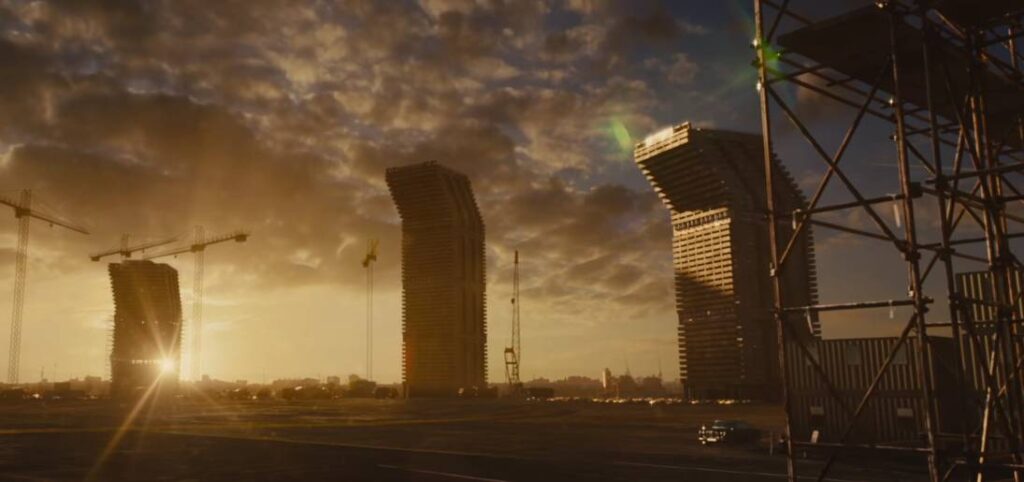 Still from the movie HIgh-Rise ( 2015). Directed by Ben Wheatley based on the novel by JG Ballard
Still from the movie HIgh-Rise ( 2015). Directed by Ben Wheatley based on the novel by JG Ballard
In that Empire, the Art of Cartography achieved such Perfection that the map of a single Province occupied an entire City, and the map of the Empire, an entire Province. In time, these Excessive Maps did not satisfy and the Colleges of Cartographers erected a Map of the Empire, which was the size of the Empire and coincided punctually with it.
Jorge Luis Borges
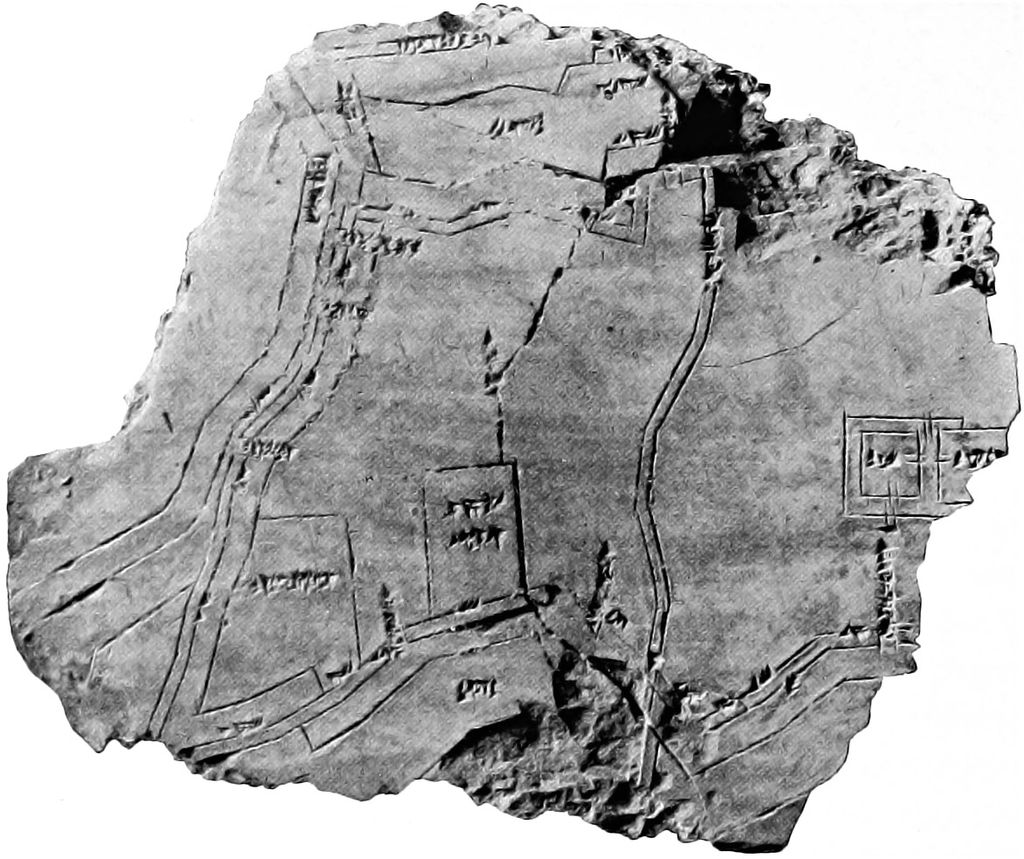 Clay tablet with map of the Babylonian city of Nippur (ca. 1400 BC)
Clay tablet with map of the Babylonian city of Nippur (ca. 1400 BC)
Since we began mapping the world to discover new territories, disseminate knowledge, create new trade routes, and expand military powers, we have exploited the horizontal.
We have charted and drawn elaborate maps of the world’s surface (as much as we knew about it), including physical places, and the mythologies of strange lands with their mythical inhabitants. Some ancient cultures did not have maps but Cosmograph, formal and symbolic representations of various worlds organized vertically with supra terrestrial heavens and infra terrestrial hells.


This view of the world was then replaced by horizontal maps that linked new scientific discoveries in surveying with political power, made possible in the 15th century by what Benedict Anderson calls “Print-capitalism. Printers were able to seek new markets that were not only Latin, especially ones of vernacular languages.
Because of the printing press, the map of Mercator made a significant advancement to cartography facilitating sail men to travel the seas more directly and accurately. There had not been a better map system since Ptolemy’s map during the Hellenistic era based on Platonic cosmology. However, Mercator still displayed fictitious geographies.
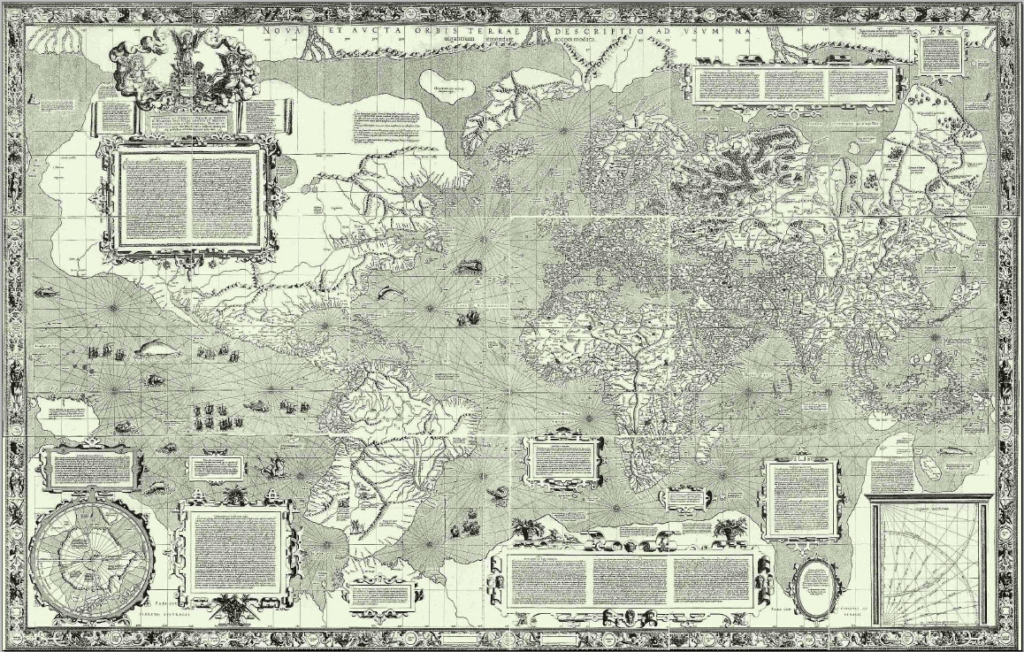 Nova et Aucta Orbis Terrae Descriptio ad Usum Navigantium Emendate Accommodata “Nueva y más completa representación del globo terrestre adaptada adecuadamente para su uso en la navegación” Gerardus Mercator 1569
Nova et Aucta Orbis Terrae Descriptio ad Usum Navigantium Emendate Accommodata “Nueva y más completa representación del globo terrestre adaptada adecuadamente para su uso en la navegación” Gerardus Mercator 1569This horizontal geography also became political geography where borders and regions were lines on a flat map representing new notions of colonial territory and economic geographies.
We could argue that the globalized economy began with the Silk Road routes established during the Han Dynasty in China and opened trade with the West in 130 B.C., until 1453 A.D.
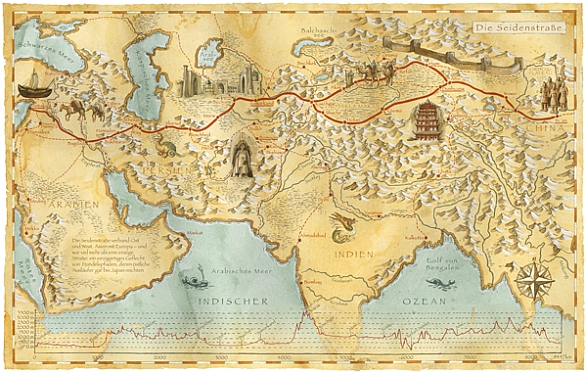 In 1877 the term “Seidenstraße” (Die Seidenstrassen, literally “Silk Road”)was coined by the German geographer, cartographer and explorer Ferdinand von Richthofen.
In 1877 the term “Seidenstraße” (Die Seidenstrassen, literally “Silk Road”)was coined by the German geographer, cartographer and explorer Ferdinand von Richthofen.Many of these cartographies drove colonial expansion from the 15th to the 19th century, including in the Americas. Eventually, humankind could picture the world as a social and political construct through graphical information. Maps of power
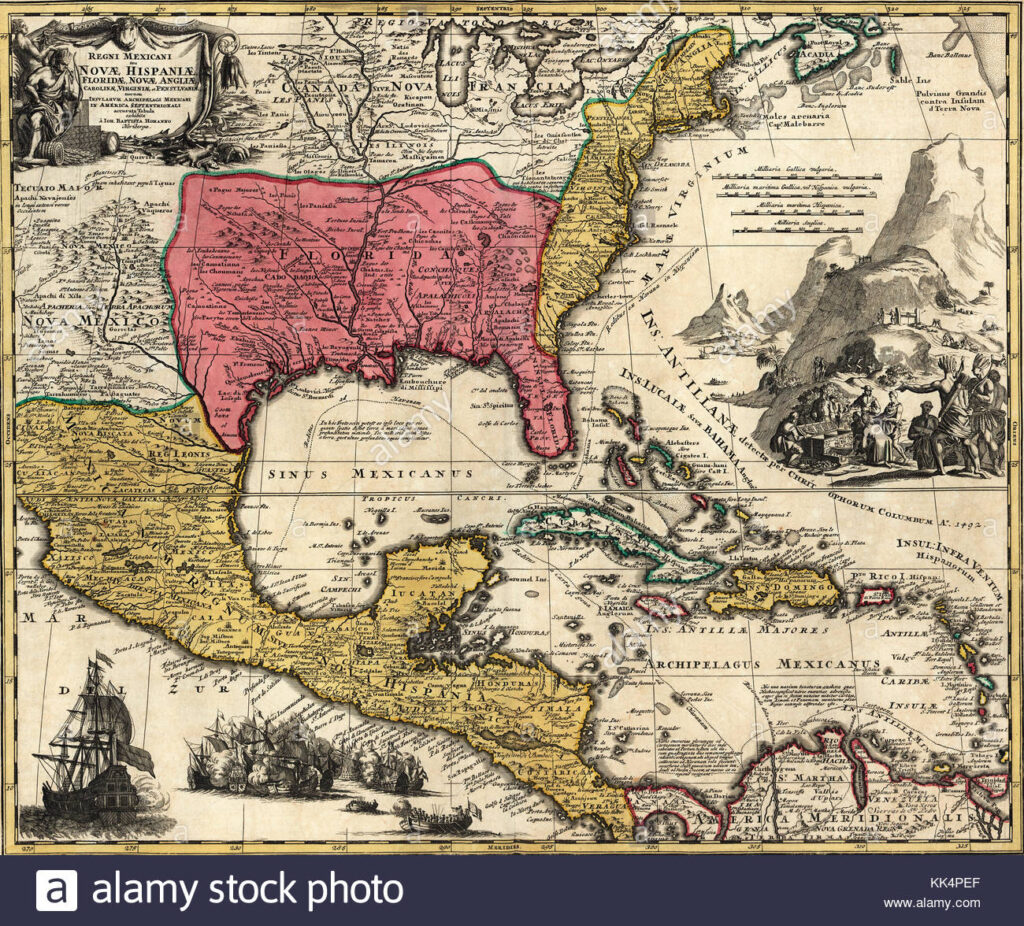 Mapa de la Nueva España 1720
Mapa de la Nueva España 1720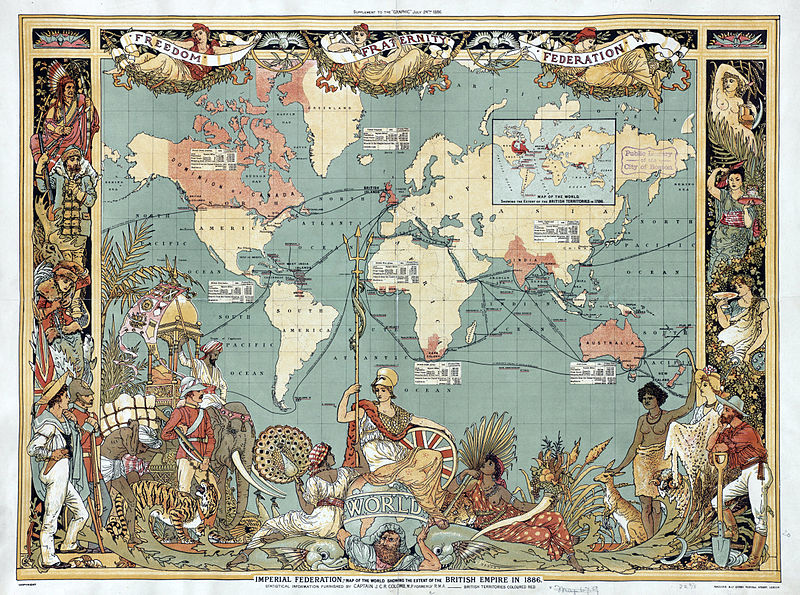 Map of the British Empire 1886
Map of the British Empire 1886Therefore, 2-dimensional maps are constructs or proxies of reality; because their views are partial and insufficient to understand the natural world’s complexities.
The cartography of the horizontal became a tool of colonial power. It is in the 20th century when we begin to defy that vision of the world. Post-colonial maps began to appear as an alternative reality in a more democratic and scientific world.
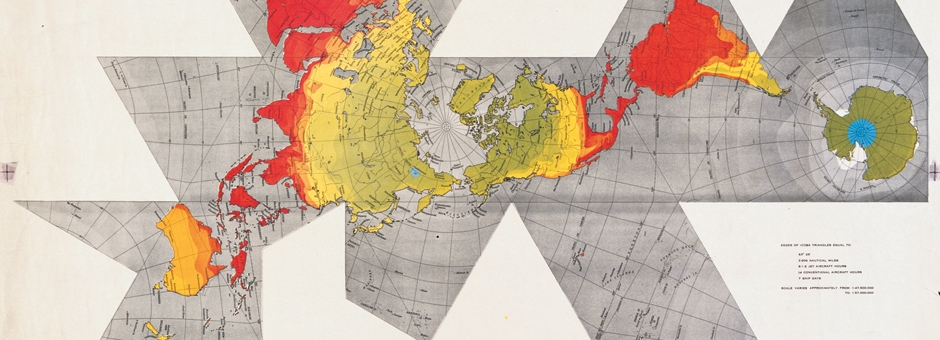 Dymaxion Map. Buckminster Fuller 1954
Dymaxion Map. Buckminster Fuller 1954Fuller Map _ Map of Spaceship earth Buckminster Fuller believed that the earth had no up or down, and all continents formed a continuous surface. His map envisions the earth with minimal distortion and represents united humanity.
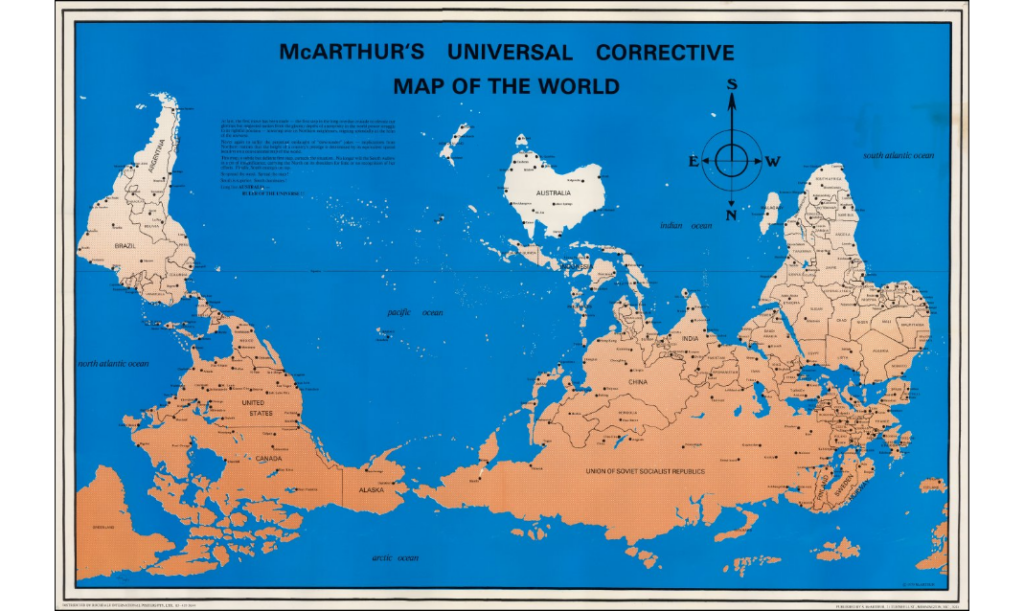 Stuart McArthur map pf 1979_turns the world upside down.
Stuart McArthur map pf 1979_turns the world upside down.Vertical Metaphors
We now live in a world of the vertical.
The domination of the earth via imaginary mapping practices at a horizontal scale is somewhat complete due to colonial activity of hundreds, even thousands of years. Every place on earth is outlined as part of a sovereign state. However, they have been done in maps that are susceptible to destruction, fire, or simply degradation.
Metaphors about the vertical are everywhere; they represent power, status, divinity, wealth, and even happiness. These metaphors have a reciprocating vertical object in our world that influences social life. They are paradoxical, both real and metaphysical.
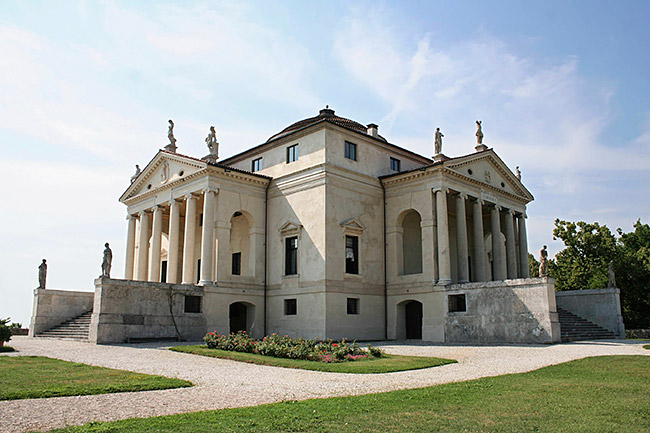 Andrea Palladio. Vila Rotonda 1590
Andrea Palladio. Vila Rotonda 1590 Le Corbusier. Vila Savoye 1931
Le Corbusier. Vila Savoye 1931Since considered a discipline, architecture is part of the struggle between hierarchy, power, and democratic space. All buildings are political constructs.
Palladio’s Villa – first idea of a home as a palace- you go up to enter- the ground is for peasants – you must ceremonially/metaphorically and physically move to a higher level.
Le Corbusier’s Villa – A an antithetical position against the ground as a symbol of power- modern man is no longer bound to the land and its owners – there is no front door, no ceremony, no semiotic value, only a political architecture of modern’s man freedom.
Le Corbusier’s utopia of a more just vertical city was drawn in his Radiant City Plan. He believed that architecture could bring social change, that architecture was powerful enough to produce a universal subject. He thought modernism was a better idea than Revolutions. As Frederick Jameson wrote, ‘he (Corbusier) saw the construction and the constitution of new spaces as the most revolutionary act, and one that could ‘replace’ the narrowly political revolution of the mere seizure of power.’
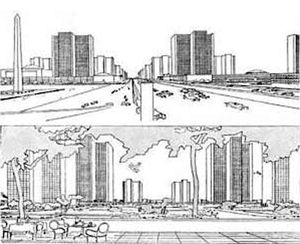 Le Corbusier. Radiant City 1923
Le Corbusier. Radiant City 1923Vertical space is now where human society builds intensive new forms of reality, from corporate high rises, low income stacked apartments, and even favelas or informal communities that tend to be built in the higher areas of a city such as hills even mountain terrain.
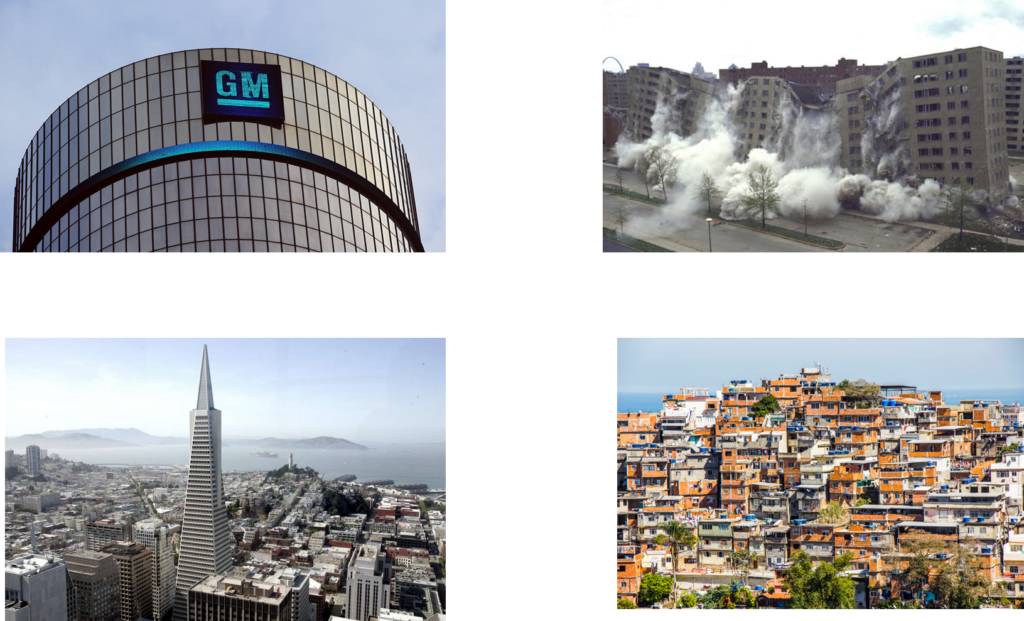 GM Renaissance Center. John Portman 1973. Transamerica Pyramid. William Pereira. 1969. Pruitt Igoe. Minuro Yamasaki 1956. Favela in Brazil
GM Renaissance Center. John Portman 1973. Transamerica Pyramid. William Pereira. 1969. Pruitt Igoe. Minuro Yamasaki 1956. Favela in BrazilMoreover, around the globe, the questions of horizontality become superseded by questions of verticality. “Since the 1980s, urban space has become more and more walled off with the middle- and upper-income classes increasingly residing in what have been termed fortified enclaves, while the poor remain in either slums or favelas”. Herzog
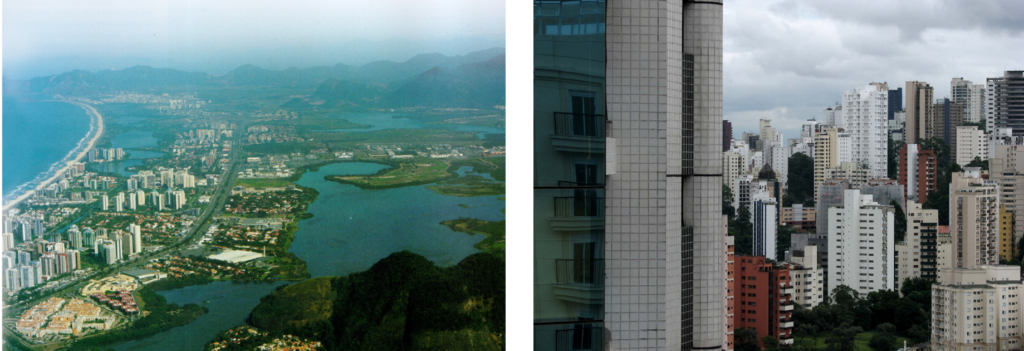 Rio de Janeiro. Photo: Larry Herzog
Rio de Janeiro. Photo: Larry HerzogThe city with the best postcard wins! The Image of high rise or vertical archipelagos have been the model to display economic growth, yet behind the image there is segregation.
“The erotic charge of the skyscraper was more explicitly related to phallic erection and penetration informal discussions of towers as including base, shaft, and tip, and in graphic visions of the skyscraper… Many architectural renderers of the 1920s, such as Hugh Ferriss, often utilized perspective to convey a sense of upward thrust, enhanced by strong lighting from below. Lighting could suggest ejaculation as well as erection… “
Dolores Hayden, from her essay Skyscraper Seduction/Skyscraper Rape

A Future(less) verticality
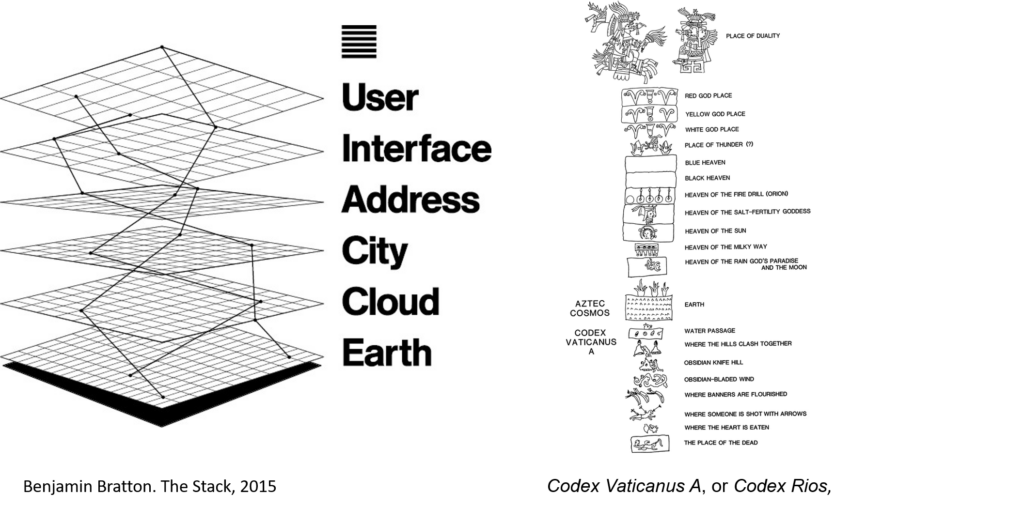
According to theorist Benjamin Bratton, today’s world is a stack of vertical layers that includes territories and other vertical geographies such as subsurface resources, cities, satellites in space, and digital domains. Power is no longer just on the surface!
“The layered cosmos of ancient Aztecs of central Mexico is a skyscraper with 13 upper stories that share the floor at ground level with the nine basements. This universe’s levels are identified and illustrated in Codex Vaticanus A, or Codex Rios, a sixteenth-century manuscript written in Italian and thought to be a copy of a lost indigenous original. The treatise deals with Aztec religion, history, customs, and calendar (Illustration Griffith Observatory, Joseph Bieniasz, after Codex Vaticanus A.”
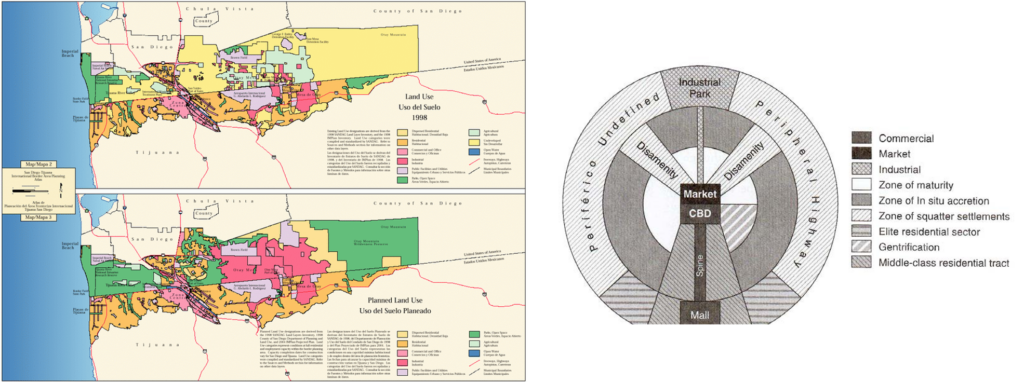
Today mapping in all its differentiation is part of the digital realm; they do not disappear; they hold their view and are susceptible only to scrutiny. They correlate with each other to produce their truths needed to manipulate our sense of the environment. They are not maps but instruments of abstraction.
We live in the predicament of representation. However, as Stephen Graham mentions, the line as a border “neglects our three-dimensional politics.”
Our regions’ border political issues might be that Washington and Mexico City still perceive the border as a two-dimensional line on a political map rather than a 3-dimensional lived border territory and not an imaginary one.
However, we see that cities are also abstracted into flat diagrams and maps of traditional planning protocols and make it difficult to understand human interaction and social space complexities.
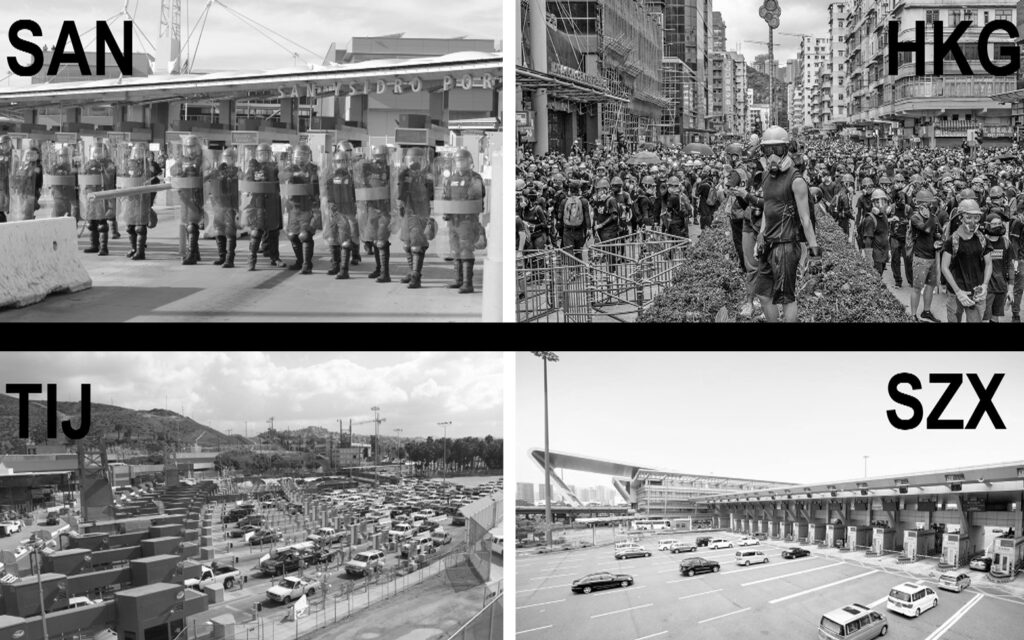
Henri Lefebvre, in his book Urban Revolution, mentions,” Cities have always been “centers of conflict, change, and transformation”; for Lefebvre, the city and its urban spaces are the stages of capital and social struggle.
These visions of the world now dominate our urban imaginaries in Latin America and the developed world. Globalized capitalism reconfigures itself into the force that is rebuilding our vertical worlds into segregated spaces once conditioned on the horizontal realm through gerrymandering and other exclusion tactics.
After the cold war and the threat of complete nuclear annihilation from the air, the city ground is the new battle zone. It stages all our ills and conflicts arisen from social inequality, corruption, climate change, the industrialization of farming, etc. The new era of warfare has moved from open fields to highly urbanized and horizontal dense cities towns. Virilio once again states, “Just as the enclosure of the city protected it from its external enemies, it will also be fortified against the enemies from within…”
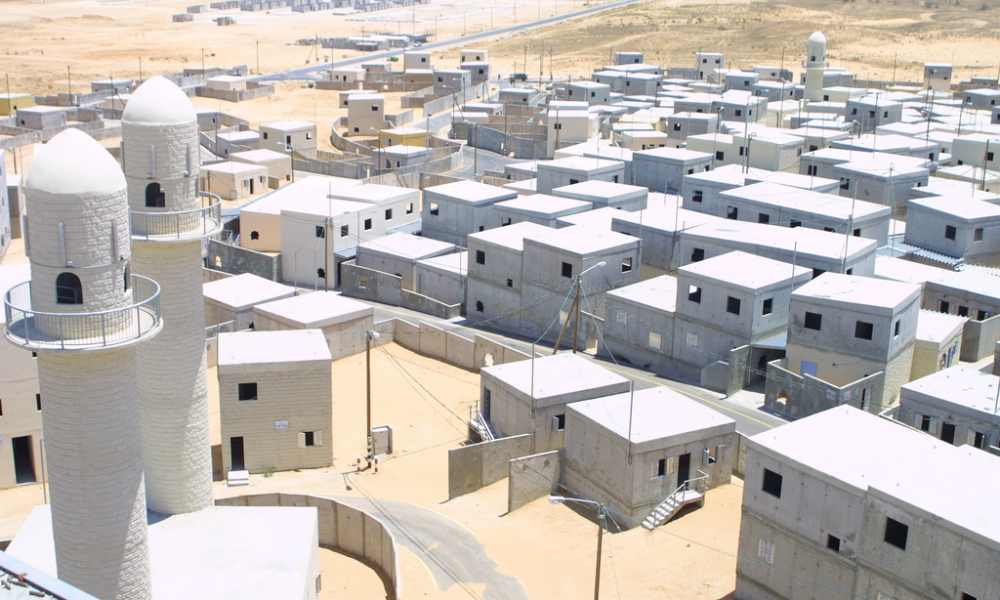 The Israel Defense Forces’ Urban Warfare Training Center (Credit: John Rice, US Army Corps of Engineers)
The Israel Defense Forces’ Urban Warfare Training Center (Credit: John Rice, US Army Corps of Engineers)Today, the barrios farthest from the cities continue to be the marginalized ones, and it has begun to include all living on the lower grounds as the antagonist to the few who can accommodate life in the air saved by protective walls around vertical archipelagos that promote a new lifestyle reality.
“The binary opposition between above and below as moved seamlessly and stealthily from Cosmological and metaphysics into the language of political rhetoric, geography, and social sciences.” Stephen Graham
As Mark Fisher writes, “Climate change and the threat of resource depletion are not being represented so as incorporated into advertisement and marketing. The structure of what capitalism realism depends.” That is why our city planning documents look more like marketing studies than urban planning instruments.

The Science Fiction of Cities
Dystopia the new dead metaphor
Cities are now being formed by this imaginary capitalism that intends to say that our problems, including city planning, the environment, and climate change, can only be solved through economic progress, an imaginary that presents itself as an inevitable real evolutionary process.
Therefore, in this sense, verticality as a way of social construction is not questioned but fantasized. The subject is mediated; we need to bring back the re-ambient the subject. We can only ask, when will it be our turn? According to Lefebvre, “Capitalism reaches so globally, so deep into the earth, so far into outer space that it threatens nature itself.”
 Real estate companies marketing schemes for high-rise buildings in Baja California
Real estate companies marketing schemes for high-rise buildings in Baja CaliforniaIn science fiction The future is no longer contested; in these films, the protagonist flees to another reality to an outside trying to recontextualize himself with his humanity.
Like the science fiction writer, Bruce Sterling stated that (in Science Fiction) living vertical denies living in the Anthropocene because you feel humanity has failed.
 Deckard and Rachel escape the city in the Theatrical Cut of Blade Runner
Deckard and Rachel escape the city in the Theatrical Cut of Blade RunnerHigh Rise is a film that portrays the perils of modernism failed towers in the park and its universal user. The Brutalist buildings house middle- and upper-class occupants are enjoying the fantasy that only a vertical metaphor can give you. The building dominates its inhabitants to the point of delusion and psychosis. The building is a metaphor for what will go wrong.
“A brief review of skyscraper history illuminates a painful dialectical process with alternating themes of reality and fantasy, rape, and seduction.” Dolores Hyden
 Still from the movie HIgh-Rise ( 2015). Directed by Ben Wheatley based on the novel by JG Ballard
Still from the movie HIgh-Rise ( 2015). Directed by Ben Wheatley based on the novel by JG BallardConclusion
Rethinking the contract with the city
How do we bring social value to our urban realm through architectural thinking?
I say architecture thinking because architectural objects are disconnected from the property. They are no longer dwelling because they lack what Heidegger called Daisen (being there, presence). Having land or a house used to be a right; today, the right is to build the house, it’s an abstract act._ is an abstract condition of capitalism.
Therefore, developers are only exercising their right to build a Highrise, and we cannot legally refrain them from doing so.
If there is no correlation between the land and the object in the contract, then there cannot be real physical planning of the city; there is only capital movement through a series of abstract rights. Therefore, what is the city?
The city is a contractual business model of capital flows. Moreover, If this is the case, then there is no need for a state, there is no need for a strong government because capital is producing our cities. No need for borders; everything is transnational; it is beyond our mapping of the horizontal. As Gilles Deleuze mentions, “Capitalism is a force of deterritorialization.”
How do you produce architecture within or outside this abstracted form of contractual capital that the city is currently made from?

